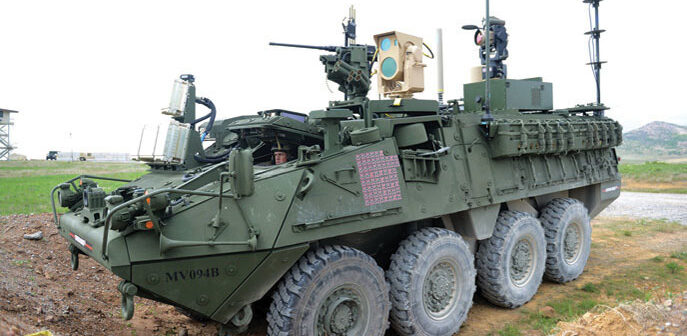It is not often that one sees a new weapon emerge on the battlefield that significantly changes how targets are neutralized or destroyed. The invention of gunpowder in China in the 9th century, followed by harnessing its power to propel projectiles in the 12th century, led to the end of spears, arrows, and catapults as wartime weapons of choice. Since then, nearly all weapon systems impact targets through kinetic effects that are produced either directly by a projectile, such as a bullet or Missile Defense Agency (MDA) hit-to-kill interceptor, or by shrapnel combined with blast overpressure effects, as with a 155 mm artillery shell or a Standard Missile block 2 fired from a Navy surface combatant. Although we have increased the rate of fire, range, accuracy, agility and area coverage, in the end, we are still, except for nuclear weapons, delivering kinetic effects. Nuclear weapons are clearly an outlier in that they primarily produce blast overpressure with a large fireball and heavy radiation close to the detonation point.
New threats have emerged, such as weaponized large and small unmanned air systems (UAS), the latter sometimes referred to as drones, increasingly robust advanced missile systems, and hypervelocity weapons. These threats have been infused with complex highspeed electronics for capabilities like command and control, higher accuracy, and stable flight, and they have been developed with requirements to operate in the electromagnetic environment (EME) that they were expected to encounter during their use, whether it’s a drone inspecting a pipeline, or a missile used in combat. Here, we will include optical (i.e., laser) frequencies in our definition of the EME. In most cases, the EME that was factored into those system designs was comprised of non-hostile unintentional electromagnetic (EM) sources, such as communication and radar emissions, or for some weapons, a hostile EME created by conventional Electronic Warfare (EW), as discussed later. Since the 1960s, the US government has made significant investments in developing capabilities that are specifically designed to create an intense EME to disrupt, damage or destroy targets in combat. These capabilities are referred to as directed energy weapons (DEWs), and while they have been popularized in science fiction for over a century, they are now finally becoming an operational reality.
DEW technologies typically take the form of: 1) high-energy lasers (HEL); 2) high-power microwave (HPM) or high-power radio frequency (HPRF) systems; and 3) charged or neutral particle beam weapons, which are technically immature relative to the first two categories and will not be addressed in this series. Both HEL and HPM/HPRF systems are now emerging, and initial prototypes are being developed and integrated into various platforms to allow warfighters to assess their military utility. The first installments of this DE101 series introduce the activities and topics that need to be addressed to support the development, integration and operational employment of DEW capabilities. The author intends it to be a primer on the topic of operationalizing DEWs, with subsequent articles to follow that explore those activities in further detail.

The US Navy has been evaluating high-energy lasers on its ships beginning with the AN/SEQ-3 Laser Weapons System deployed on the USS Ponce in 2014. US NAVY PHOTO
ELECTRONIC WARFARE, ELECTRONIC ATTACK, AND DIRECTED ENERGY WEAPONS
Electronic warfare (EW) is typically defined as the art and science of preserving the use of the EM spectrum for friendly use while denying its use to the enemy. Since its inception, the EW community has been very successful in using electromagnetic energy to deceive, deny or degrade enemy sensors and weapon systems, so much so that there are a number of formal EW Programs of Record (PORs) and entire platforms dedicated to the EW mission. The Boeing EA-18G Growler and the Lockheed EC-130H Compass Call aircraft are two examples. The primary subdivisions of EW are electronic support (ES), electronic attack (EA), and electronic protection (EP).
Conventional EA takes advantage of a target’s intended RF or optical sensors. Using detailed knowledge of how inputs from those sensors are processed by the target’s electronics, EW practitioners develop techniques to generate operationally useful impacts on the targeted system for various scenarios. Joint Publication 3-13.1, “Electronic Warfare,” states that DEW is a part of the EA subdivision of EW, although the technical communities and funding streams for EW and DEW tend to be somewhat distinct. Recent activities by the Directed Energy Professional Society (DEPS) and the Association of Old Crows (AOC) aim to enhance the collaboration between the two communities.

The US Army sees HELs playing a role in short-range air defense applications, especially against drones. Above, a prototype Multi-Mission High Energy Laser is installed on a Stryker. US ARMY PHOTO
HIGH-ENERGY LASERS
The impact of HEL and HPM/HPRF weapons on a target appreciably expands the range of effects typically generated by conventional EW systems. Most HEL weapon systems currently being developed or deployed can be categorized as solid-state, high average power, continuous wave (CW) lasers that impact a target by delivering a sufficient power density (in Watts/cm2), at a predetermined aimpoint for a sufficient engagement time, to accumulate the energy density (in Joules/cm2) required to create the intended structural damage to the target or its electronics. This kinetic-like effect that HEL weapons have on targets, much like a blowtorch at a distance, is well understood by senior military leadership, which has resulted in considerable funding in this technology area.
Other short-pulse and ultra-shortpulse (USP) lasers are also being evaluated to determine their viability as HEL DEWs. Unlike CW lasers that rely on energy deposition to damage a target, USP lasers create highly intense pulses of light, in the terawatt range (1012 Watts) or higher, for extremely short periods of time, typically less than a picosecond (or 10-12 seconds). The resulting power density on target can damage optical sensors or create surface ablation effects. USP laser atmospheric propagation effects are also being studied to determine its DEW viability. Laser propagation in general is a critical issue for consideration for all HEL weapons.¹

HPM weapons, such as the Phaser, are being evaluated for counter-UAS missions. US ARMY PHOTO
RF WEAPONS
For this discussion, we will refer to an HPM/HPRF weapon as an RF weapon (RFW). Most RFWs in development for counter-materiel applications rely on the creation of extremely high peak powers, in the range of megawatts to terawatts effective radiated power (ERP), with pulses typically less than one microsecond that disrupt, degrade, or damage a target’s electronics. RFWs can affect targeted systems by either coupling energy into intended RF apertures, known as “front door” coupling, or through unintended RF apertures such as seams, non-conductive surfaces, or unshielded wires, which is “back door” coupling. One example of front-door coupling is RF energy from an RFW entering through the antenna of the targeted receiver to disrupt, degrade, or damage the low-noise amplifier (LNA) on the front end. In backdoor coupling, RF energy couples into circuits within the targeted system, resulting in the creation of transient voltages that can disrupt their operation or even exceed their physical limits (which in some cases is only several volts) causing breakdown or arcing within the microchips themselves. Unlike conventional EW, these RFW effects in most cases will continue in the electronics after the RF illumination has ended.

The NIRF system during its development phase. DOD PHOTO

HPM technology has seen dramatic reductions in size-weight and power over the past several years. Above, the Active Denial System requires a truck. SMC PHOTOS
Two counter-materiel RFWs with very high average powers are the counter-IED systems called the Neutralizing Improvised Explosive Devices with Radio Frequency (NIRF) system that the Navy/Marine Corps deployed to Iraq in 2005, and the MaxPower system that the Air Force deployed to Afghanistan in 2012.
RFWs can also be used for counter- personnel applications. The most well-known example is the Active Denial System (ADS) developed by the Joint Non-Lethal Weapons Directorate in Quantico, VA. The ADS basically works as a CW RFW at a millimeter wavelength, corresponding to a frequency of 95 GHz. When directed at human skin, this frequency is absorbed in the first 1/64 inch, causing a quick and reversible heating sensation that does not penetrate the target.

the more recent Solid-State Active Denial Technology demonstrator fits on a table top. SMC PHOTOS
Rather than go into technical depth about the DE-related efforts underway in the Department of Defense (DOD), the initial series in this column will address the need to change the discussion from DEW technology capabilities to DEW support for warfighting functions, as well as the actions by the technical community, policymakers, and leadership required to support that transition. This series will also focus on what it will take to gain warfighter acceptance of HEL and RFW capabilities, since these systems have reached the point of being ready for operational testing and evaluation and, in some cases, operational use on the battlefield. Acceptance will mean that warfighters have confidence that the DEW will function as intended when the “trigger” is pulled, and that it will have the desired impact on the target.






